Learn how to convert any recipe to sourdough with a few easy tricks. Eating healthy fermented grains doesn’t have to be challenging. Just use this simple process to convert your favorite recipes to sourdough.
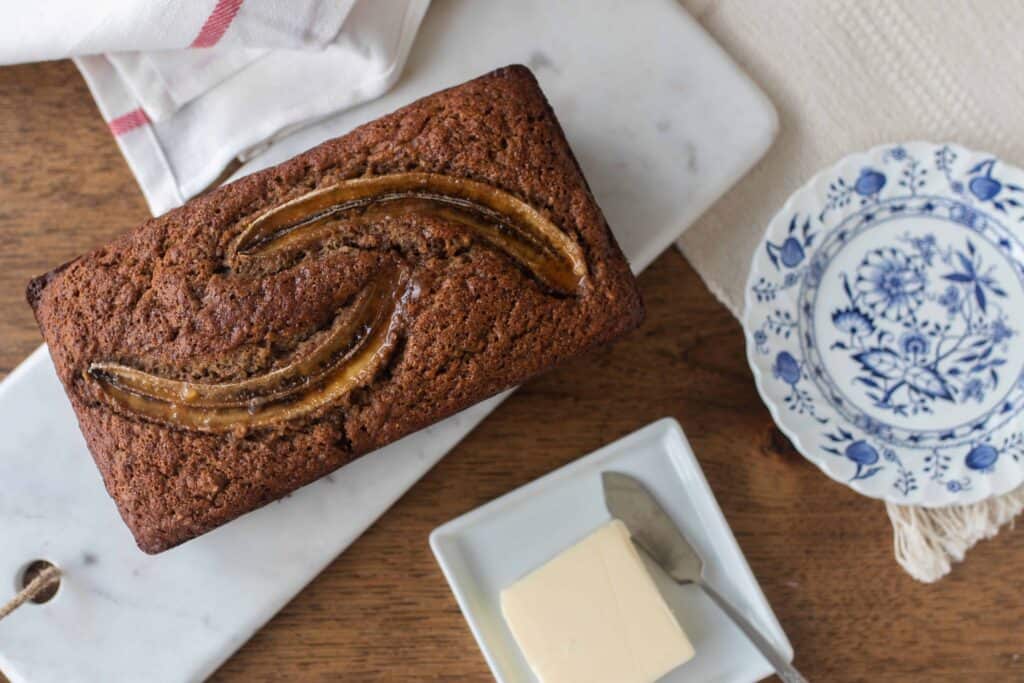
If I had a food love language, I’m sure it would be sourdough. And by this point, you’ve all figured this out.
It’s been a 10-year love affair with this healthy, ancient way of eating grains. Once converted, it is truly hard to go back. Our family is never going back.
Honestly though, sourdough doesn’t have the best reputation. People have a misconception that sourdough is difficult and takes a long time.
You might be imagining yourself spending several hours a day kneading dough, or even hunkered over your bread bowl with your sourdough instructions, trying to troubleshoot your dough like a bad chemist.
That is just not the case. Sourdough has simplified meal making and food prep dramatically for our family.
Converting a recipe is actually quite simple. You may have to tweak it a bit, but it is really worth it. Between the health benefit of easier digestion and the greater depth of flavor, you’ll be thankful you made the switch.
There are multiple factors when considering converting a recipe to sourdough. Consider the type of recipe, how much liquid and flour, and whether or not another leavener may be added.
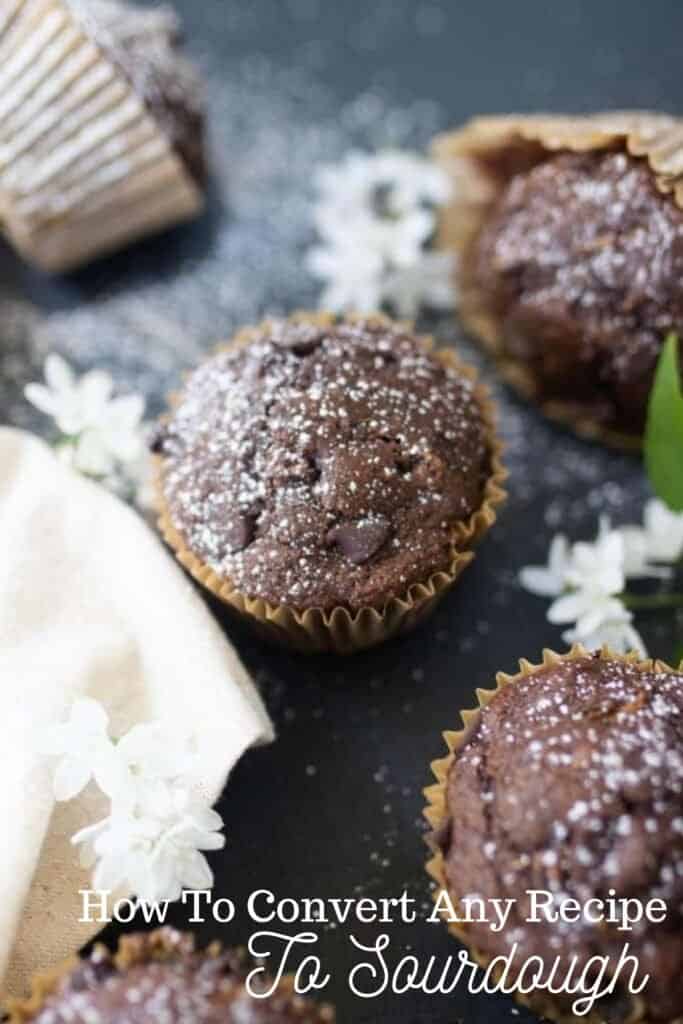
Why would you want to convert a recipe to sourdough?
- Flavor: Sourdough adds a delicious tang and complexity to grain products. From savory to sweet, the dimension added can’t compare with regular wheat products. Once you switch to eating traditionally fermented grains, regular grains seem sub-par and lacking flavor.
- Health: Switching to grains fermented with sourdough starter reduces the amount of phytic acid present in the grains, and allows the nutrients (like folate) to become more bio-available. Your body then can more easily absorb these nutrients.
- Digestibility: Fermented grains actually contain less gluten than unfermented. The good bacteria and yeast help break down the gluten, making it easier for your body to digest. Those who have difficulty digesting grains may be able to tolerate long-fermented sourdough products. Those with celiac disease still should avoid any glutinous grains, even fermented ones.
How To Convert Any Recipe To Sourdough:
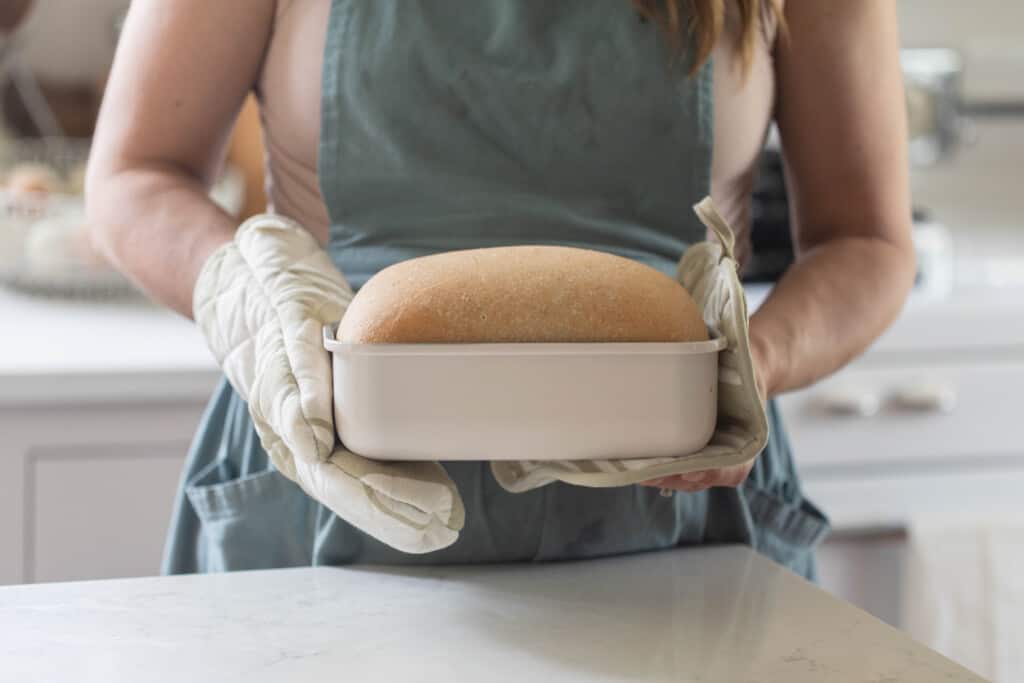
Yeast Recipes:
When I started my sourdough journey, I took the yeast bread recipe I had been using and adjusted to work with sourdough.
So, I know it is possible to take your favorite yeast bread recipe and make it using the wild yeast from sourdough starter instead!
If you’d like to do this with any of your go-to recipes, there are three basic rules I follow.
- Swap out one packet of yeast for a half cup of starter.
- Reduce the liquid by ⅓ cup + one tablespoon and reduce the flour by ⅓ cup + one tablespoon.
- Increase rise time, usually double.
Want to know how I came up with this super scientific recipe conversion? I simply added ⅓ cup + one tablespoon of flour and water to a bowl, and measured it. This combination equals exactly a half cup of “sourdough starter”, so we are simply adding the starter to the recipe and taking the liquid and flour volume back out.
You can use this same process to work with your own conversions for different types of flours and recipes.

Non-Yeast Recipes:
There are many quick-bread recipes that work well when converted to sourdough, like pancakes, crepes, muffins, and other quick breads (hello, banana bread).
Now this can be a little trickier since many non-yeast recipes (like cookies, quick breads, etc) don’t contain a lot of liquid. For recipes like this, I would suggest adding a half a cup of sourdough starter, and possibly increasing the amount of flour a bit.
I say possibly because you may be able to get away with adding 1/2 cup of starter and not having to do any else differently to the recipe.
For other recipes, you could possibly reduce the amount of oil added while also adding more flour. I would suggest trying 1/3 cup for both.
Honestly, this conversion works best for yeast breads, but can be done with others as well. If all else fails, I have just about every sourdough recipe you could think of on the blog.
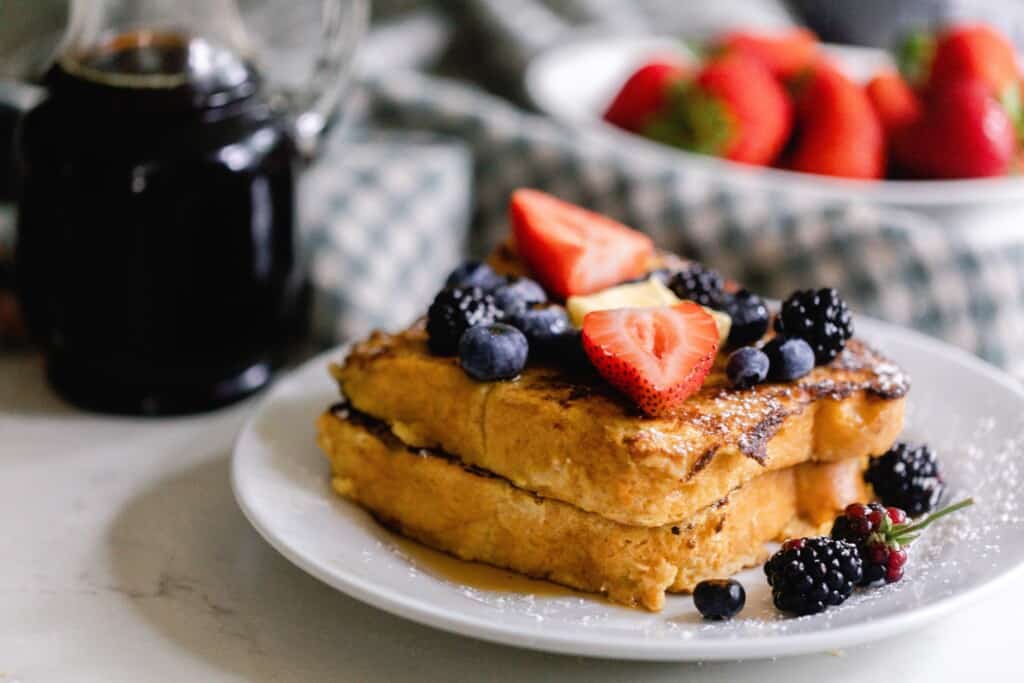
The hydration of your starter matters when making these adjustments!
The conversion example above is based on a sourdough starter fed at 100% hydration. I feed my starter equal parts flour and water.
The amount of flour and water used is based on the amount of starter I already have. But the ratio of flour to water never changes.
If you feed your starter a different ratio of flour to water, your recipes will need to be adjusted accordingly.
You can also use sourdough starter in your quick bread recipes as well!
The basic principle given previously still works here: add starter, reduce flour and water to equal the volume of the starter added. ½ cup starter at 100% hydration = ⅓ cup + one tablespoon of flour and water.
Try Some Of Our Favorite Recipes
- Sourdough Brownies
- Buffalo Cauliflower Wings
- Sourdough Strawberry Cream Cheese Cobbler
- Easy Artisan Bread
- Sourdough Banana Bread
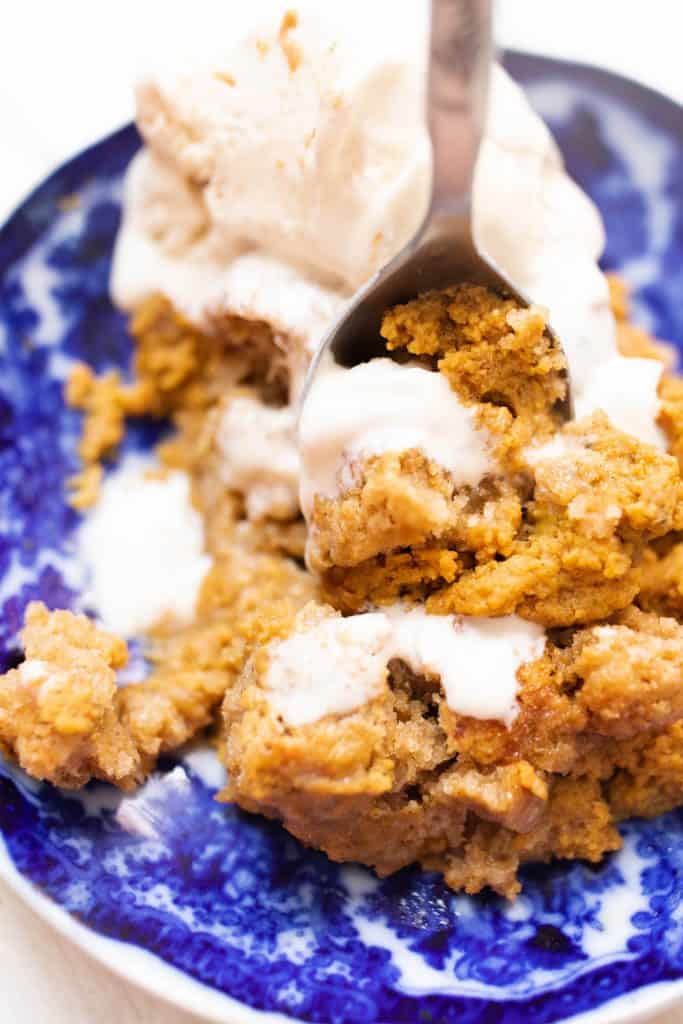
Why does sourdough need a longer rise time?
Typically, rise time will take about double the time, as the natural yeasts and bacteria take more time to develop than commercially developed yeast. While a yeast bread may take 1-2 hours to rise, give your sourdough recipe at least 4 hours.
If you are making a bread recipe, make sure to double both rises. The bulk rise, and the second rise after shaping.
With sourdough, you can even do longer rises in the refrigerator to help develop flavor without over fermenting.
For bread, you would allow a bulk ferment after starting the dough, and then a second ferment in the fridge, covered with plastic, for up to 24 hours.
Differences in rising time will change substantially depending on the type of recipe, if it contains other leaveners like baking soda, the environment it is rising in, etc.
FAQ:

How much sourdough starter equals a packet of yeast?
A packet of yeast roughly equals 1/2 cup of sourdough starter in a recipe.
Is it cheaper to buy or make sourdough?
It is much cheaper to make your own sourdough bread compared to buying it.
What is the ratio of sourdough starter to baking?
While many bakers may choose a different ratio, the most common is one part flour to one part water, to one part sourdough starter (1:1:1)
Sourdough might sound complicated, but most new processes do. Take some time to read and learn about sourdough, give your own starter a try, and I promise, you’ll find it to be a simpler skill than expected.
It’s an incredibly beneficial practice, both for your health, and for the depth of flavors you build into your recipes.










Thanks for the valuable information.
My regular bread recipe only rises, for 1 minutes, punch down, rise 15 minutes ( 2nd rise); put in pans and let rise in bread proof oven for 1hour, and bake at 350. For 20 minutes.
How can I adjust this rise, and bake time if I use sourdough starter?
Thanks,
You will need to ferment over night. Sourdough has to have time to rise. It doesn’t rise automatically.
thank you for this but wish it was in grams rather than cups as that can change things. How many grams of starter do you use? And from the other comments I think I may have done the wrong conversion as I figured out how much flour vs. water weighs for the 1/3 cup plus TBS. Came up with 94g water and 51g flour, but if you are doing by weight, might be wrong… So a bit confused.
Hi! I have a conversion chart for my recipes. Here it is.
How do you use potato flake starter discard in recipes using sourdough, when it is so much thinner? Does it just replace liquid, and flour amount stays the same?
You will have to adjust accordingly with the flour. I usually just go by consistency.
Another group who benefit from sourdough are many people who have IBS. As long as the recipe uses wheat or spelt and doesn’t include high fodmap ingredients (fruit, garlic, etc.), it is considered a low fodmap option.
When you mention your starter, you mention one part flour with one part water and one part sourdough, do you do that based on weight or cup measurements? For example, do you feed 50 grams flour and 50 grams water to 50 grams sourdough? Or do you do something like 1/2 flour and 1/2 cup water with 1/2 cup starter? I ask because the different methods yield a very different hydration in the sourdough, which I realize can greatly impact recipes because 1/2 cup flour weighs approximately 60 grams but 1/2 cup water weighs approximately 114 grams. This means when measuring by cups you end up with almost double the amount of water versus measuring by weight. Thank you for your help!!
I usually measure with my scale for more precision. You can measure by cups though and it works out fine!
Hi! We have been using an all einkorn sourdough starter for a bit and we struggle when trying to adapt recipes solely using einkorn. (We have a great sourdough einkorn bread recipe though!) do you have any insight to the adjustments that would be appropriate for using an einkorn sourdough starter + einkorn flour (from a wheat/all purpose flour recipe)?
There are some tricks for subbing einkorn like using ⅓ less liquid or using more flour. However, it can be really tricky to convert a recipe to einkorn. It just takes some experimenting to get right!
I’m new to sourdough! I love your recipes. I would like to convert a SD hard pretzel recipe to all sourdough.The recipe calls for 3 cups warm water and 3/4 TBL yeast in addition to a sourdough mixture of 1/2 cup flour and 1/2 cup water plus 1/2 tsp yeast. How would you eliminate/replace the water with yeast mixture? Thanks..
If the recipe includes sourdough starter, you may just be able to eliminate the yeast (keep the water it calls for), and then just lengthen the rising time. Usually it takes 8-12 hours to bulk rise sourdough compared to the 2 hours recipes with yeast calls for. Then shape and rise again. I have a pretzel recipe you could try: https://www.farmhouseonboone.com/the-best-soft-sourdough-pretzels.
Hi Lisa, thanks for sending me this. I am Greek living in England and would love to use sourdough pastry for my delicious Greek spanakopita and tyropita (cheese pie). This article will help me do this. Thanks again. Btw, I eat mainly plant based foods but still enjoy your recipes and videos very much!
That sounds like a delicious way to use the sourdough pastry. So glad you are enjoying the recipes
Hi I am from Spain and I would really appreciate if you could translate those “cups” in european Measure like the good ol’ grammms!!
We are slowly working on it. This post will help figure out the grams for my recipes: https://www.farmhouseonboone.com/baking-conversion-chart
Thank you for these guidelines. I need to convert recipes for easier digestion. When do you long ferment an entire recipe in the fridge overnight and when do you long ferment on the counter and add more ingredients afterward?
Thats a good question. If the recipe has eggs, baking powder, and or baking soda I will typically leave those out until after the fermentation. I do most fermentation on the counter. The only recipe I really ferment in the fridge is cookies (unless it is a bread recipe that can be refrigerated for the second rise). For cookies, I have found that a 2-3 day ferment works best for fermentation.
So great of you to simplify this for your readers, Lisa! I’m a sourdough newbie and this gives me COURAGE!!